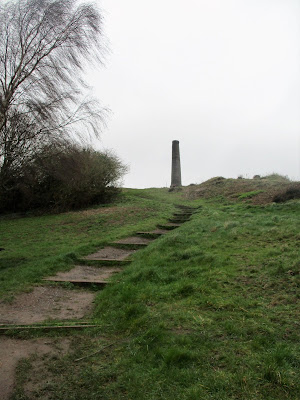We were heading for a place we'd never visited, namely Troopers Hill, which looms high over the River Avon in the east of the city.
It's now a nature reserve, but in the past it's been mined and quarried, and housed a copper smelting works.
From the top of the hill there are extensive views over the centre and south of the city ...
... although the wild weather wasn't conducive to seeing them.
This is looking south-west, over St Annes in the immediate foreground, and (eventually) Dundry.
This is looking west towards the centre of the city. You can see the course of the River Avon by the shape of the tree-covered hill. Right in the centre is a misty spire belonging to St Mary Redcliffe. (You'll have to take my word for it.)
 Looking east along the Avon valley
Looking east along the Avon valley
Since it was so bitter on top of the hill, and raining too, we decided to wander down through the workings, where it might be a little more sheltered.
Troopers Hill has had a number of names over the years. It was known as Harris Hill, Ghosthills and Trubody's Hill on 17th century maps.
'Ghosthills' is believed possibly to have been a local pronunciation for Gorsehills. Likewise, Troopers Hill could be a corruption of Trubody's Hill ...
... or a folk memory of its alleged role during the Civil Wars, when the Parliamentary Army, under the command of Sir Thomas Fairfax, camped there prior to the siege of Bristol in 1645. (It's less than a three mile ride from Wickham Court.)
The hill's pennant sandstone was quarried and used to build many local buildings; also, less predictably, St Peter's Church in Stow Bardolph, Norfolk.
It was also mined for fire clay and coal, being home to at least six mines out of the 400+ that formed the Kingswood coal field.
There was also a lot of industry down by the Avon (in the centre of this photo) at Crews Hole.
In the 18th century copper was brought in from Devon and Cornwall and smelted with zinc ore from the Mendips to make brass. Many of the brass products were exported to Africa to be bartered for slaves as part of the 'triangular trade' in which Bristol played such a pivotal role.
I'm glad the hill is a nature reserve now. It's good to see scrub, including gorse, growing in what is an inner city area. And to know that rare mining bees are continuing the tradition of digging into this hill.
We were enjoying exploring, although we did decide that that the path down to Crews Hole was altogether too muddy and slithery for me to risk going down with my track record.
I haven't found out what this stone - a marker? - is for yet.
We intend to come back again for a more extensive exploration when the weather is more clement.

















No comments:
Post a Comment